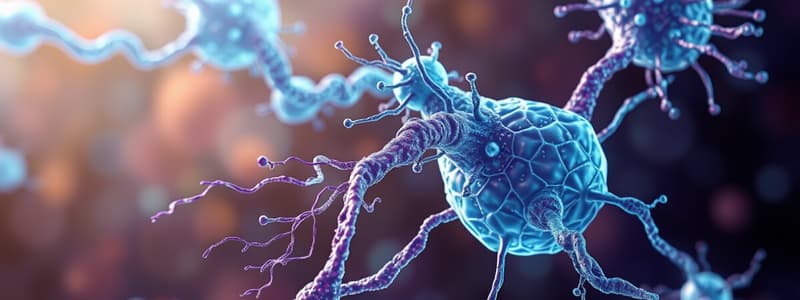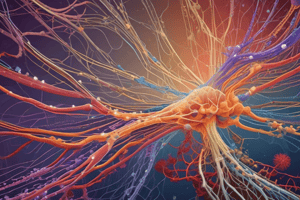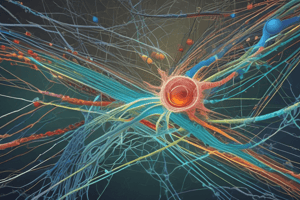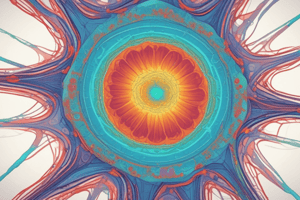Podcast
Questions and Answers
What represents the fundamental unit of intermediate filaments?
What represents the fundamental unit of intermediate filaments?
- Tetramer (correct)
- Protofilament
- Monomer
- Helical dimer
Which of the following statements regarding the interaction of intermediate filaments is true?
Which of the following statements regarding the interaction of intermediate filaments is true?
- They cannot interact with other cytoskeletal components.
- They link exclusively through plectin.
- They can link actin microfilaments and microtubules. (correct)
- They only link to actin microfilaments.
Which of the following mutations is associated with epidermolysis bullosa simplex?
Which of the following mutations is associated with epidermolysis bullosa simplex?
- Mutations in actin
- Mutations in keratins (correct)
- Abnormal microtubule expression
- Heterodimer mutations in tubulin
What is true about the exchange of subunits in intermediate filaments?
What is true about the exchange of subunits in intermediate filaments?
How many protofilaments are arranged in a typical microtubule structure?
How many protofilaments are arranged in a typical microtubule structure?
What characterizes a tubulin monomer?
What characterizes a tubulin monomer?
What is the primary defect associated with Situs inversus?
What is the primary defect associated with Situs inversus?
Which of the following agents is known to interfere with microtubule formation?
Which of the following agents is known to interfere with microtubule formation?
Autosomal Dominant Polycystic Kidney Disease (ADPKD) is primarily associated with defects in which cellular structure?
Autosomal Dominant Polycystic Kidney Disease (ADPKD) is primarily associated with defects in which cellular structure?
Which type of junctions are most directly connected to the actin microfilaments in the cytoskeleton?
Which type of junctions are most directly connected to the actin microfilaments in the cytoskeleton?
What is the possible outcome of disrupting the mitotic spindle during cell division?
What is the possible outcome of disrupting the mitotic spindle during cell division?
What term describes the ECM connections that attach to the cell cytoskeleton?
What term describes the ECM connections that attach to the cell cytoskeleton?
Which actin binding protein is responsible for inhibiting polymerisation?
Which actin binding protein is responsible for inhibiting polymerisation?
What is the primary role of villin in microvilli?
What is the primary role of villin in microvilli?
What process involves the contraction of a ring of actin in the center of the cell, anchoring to the plasma membrane?
What process involves the contraction of a ring of actin in the center of the cell, anchoring to the plasma membrane?
Which actin binding protein is known to sever actin filaments and bind to the plus end?
Which actin binding protein is known to sever actin filaments and bind to the plus end?
What structure do lamellipodia primarily rely on for cell movement?
What structure do lamellipodia primarily rely on for cell movement?
What type of filaments provide physical support and structure in epithelial cells?
What type of filaments provide physical support and structure in epithelial cells?
Which statement accurately describes the assembly process of actin microfilaments?
Which statement accurately describes the assembly process of actin microfilaments?
Which intermediate filament proteins are found specifically in axons?
Which intermediate filament proteins are found specifically in axons?
What is the primary role of intermediate filaments in the cytoskeleton?
What is the primary role of intermediate filaments in the cytoskeleton?
What key function do lamins A, B, and C serve in the cell?
What key function do lamins A, B, and C serve in the cell?
Which of the following functions is NOT associated with the cytoskeleton?
Which of the following functions is NOT associated with the cytoskeleton?
How does the diameter of microtubules compare to that of actin microfilaments?
How does the diameter of microtubules compare to that of actin microfilaments?
Which of the following statements regarding the dynamic structure of actin microfilaments is true?
Which of the following statements regarding the dynamic structure of actin microfilaments is true?
What is a major role of the cytoskeleton in cell movement?
What is a major role of the cytoskeleton in cell movement?
Which type of cytoskeletal component is primarily involved in cytokinesis?
Which type of cytoskeletal component is primarily involved in cytokinesis?
What can be inferred about diseases related to the cytoskeleton?
What can be inferred about diseases related to the cytoskeleton?
What role do microtubules play in mitosis?
What role do microtubules play in mitosis?
Which motor protein moves cargo towards the cell periphery along microtubules?
Which motor protein moves cargo towards the cell periphery along microtubules?
What are centrioles primarily composed of?
What are centrioles primarily composed of?
What is the function of the microtubule-organizing centre (MTOC)?
What is the function of the microtubule-organizing centre (MTOC)?
How do cilia differ from primary cilia?
How do cilia differ from primary cilia?
What happens to microtubules during cellular mitosis?
What happens to microtubules during cellular mitosis?
What is the primary component that maintains the structure of stereocilia?
What is the primary component that maintains the structure of stereocilia?
What is the role of Aster microtubules during cell division?
What is the role of Aster microtubules during cell division?
Study Notes
Cytoskeleton Overview
- Composed of a network of protein filaments within cells, serving multiple functions.
- Vital roles include maintaining cell shape, intracellular transport, cytokinesis, and cell movement.
- Connects with the extracellular matrix (ECM).
Three Major Components of the Cytoskeleton
- Actin Microfilaments
- Polymers of actin with a diameter of 7-9 nm; involved in muscle contraction and maintaining cell shape.
- Monomer (G-actin) binds ATP, polymerizes to form filament (F-actin), with dynamic growth at both ends.
- Constitutes about 5% of cellular protein.
- Intermediate Filaments (IF)
- Composed of various tissue-specific proteins; approximately 10 nm in diameter.
- Examples include keratins in epithelial cells and neurofilaments in axons.
- Generally stable, providing structural support to cells.
- Microtubules
- Composed of tubulin heterodimers; approximately 25 nm in diameter.
- Formed by 13 protofilaments creating a hollow tube, critical for cell organization and mitotic spindle formation.
Actin Microfilaments Details
- Actin microfilament structure features a dynamic assembly that includes a (+) end for growth and a (-) end for depolymerization.
- Important actin-binding proteins regulate filament dynamics:
- Thymosin β4 inhibits polymerization.
- Gelsolin severs and regulates filament stability.
- Plays crucial roles in non-muscle cell movement and cytokinesis.
Intermediate Filaments Functions
- Connects with actin microfilaments and microtubules, offering structural stability.
- Clinical relevance includes diseases like epidermolysis bullosa simplex from keratin mutations and amyotrophic lateral sclerosis related to neurofilamin abnormalities.
Microtubules Functionality
- Dynamic elements in cells providing a scaffold for organelle organization and cargo movement.
- Involved in chromosome separation during mitosis, with centrosomes acting as microtubule-organizing centers (MTOC).
- Motor proteins (kinesin and dynein) facilitate transport along microtubules using ATP.
Cilia and Their Functions
- Hair-like membrane extensions supported by microtubules, crucial for various movements.
- Types include primary cilia and motile cilia, with functions ranging from sensory detection to fluid movement in respiratory epithelium.
Clinical Considerations of the Cytoskeleton
- Disruption of microtubules can affect cell division, influencing cancer treatment strategies.
- Chemotherapeutics like colchicine and taxol target microtubule dynamics.
Cell-Adhering Structures
- The cytoskeleton is essential in forming junctions between cells (like desmosomes and gap junctions) and adhering to the ECM (through hemidesmosomes and focal adhesions).
Summary Points
- The cytoskeleton consists of actin microfilaments, intermediate filaments, and microtubules, each with distinct structures and functions.
- Regulation and dynamics of these components are critical for cellular integrity, movement, and functionality.
- Dysfunctional cytoskeletal components can lead to various diseases, highlighting their importance in health and disease mechanisms.
Studying That Suits You
Use AI to generate personalized quizzes and flashcards to suit your learning preferences.
Related Documents
Description
Test your knowledge on the cytoskeleton's major structural components, their assembly and disassembly, and associated proteins. This quiz will help you understand the integral role of the cytoskeleton in cell structure and intracellular motility.




